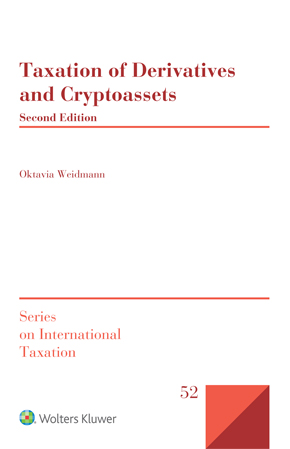| |
Pris: 2168 SEK exkl. moms  |  Taxation of Derivatives and Cryptoassets is a comprehensive book addressing the key accounting and tax issues of derivatives and cryptoassets in domestic and cross-border transactions. Specific references are made to UK, German and Swiss tax law. Taxation of Derivatives and Cryptoassets is a comprehensive book addressing the key accounting and tax issues of derivatives and cryptoassets in domestic and cross-border transactions. Specific references are made to UK, German and Swiss tax law.
While the first edition of this book focused solely on derivatives, this updated second edition adds cryptoassets, crypto derivatives and ESG investment products to the analysis. It also comments on global tax policy developments, such as the OECD Base Erosion Profit Shifting (BEPS) 1.0 and 2.0. projects.
What’s in this book:
The updated edition includes the following topics:
- basic financial concepts relating to derivatives and cryptoassets;
- definition of derivatives for tax purposes and its application to crypto derivatives and ESG derivatives, among others;
- domestic and international accounting rules applying to derivatives and cryptoassets;
- current state of the taxation of derivatives and cryptoassets in the UK and Germany and tax policy alternatives;
- characterisation of derivatives gains and losses as income or capital, and equity or debt;
- accounting and taxation of hedging transactions involving derivatives or cryptoassets;
- accounting and taxation of structured products and hybrid instruments, including those linked to crypto and ESG;
- withholding taxes on derivatives and the concept of beneficial ownership in a domestic and cross-border context; and
- anti-avoidance legislation applying to derivatives and cryptoassets, including the domestic law implementation of BEPS Action 2, the EU Anti-Tax Avoidance Directives (ATAD I and II), the tax transparency rules for cryptoassets (DAC8) and Pillar Two.
How this will help you:
This book provides an in-depth exploration of the accounting and tax treatment of derivatives, cryptoassets and ESG investment products in a domestic and cross-border context and uses various examples to illustrate the existing rules and viable policy alternatives. It is, therefore, a vital resource for anyone working in tax policy, deploying professional tax advice to companies, banks or investment funds relating to derivatives or cryptoassets, or researching those topics.
Table Of Contents
About the Author
Foreword
Preface to the Second Edition
Acknowledgements
Introduction
Reference Sources and Effective Date
List of Abbreviations
CHAPTER 1
Taxing Derivatives and Cryptoassets – An Introduction
CHAPTER 2
Basic Economic Concepts of Derivatives and Cryptoassets
CHAPTER 3
Problems in the Context of Taxing Derivatives and Cryptoassets
CHAPTER 4
Defining Derivatives for Tax Purposes
CHAPTER 5
Accounting Standards Applying to Derivatives and Cryptoassets
CHAPTER 6
The Special Regime Approach Versus the Integrative Approach, the Distinction of Income and Capital, and Equity and Debt
CHAPTER 7
The Taxation of Derivatives and Cryptoassets in the Context of Hedging Transactions
CHAPTER 8
Taxation of Structured Products and Hybrid Instruments
CHAPTER 9
Derivatives in a Cross-Border Context: Beneficial Ownership and Withholding Taxes
CHAPTER 10
Countering Tax Avoidance: Derivatives and Cryptoassets
CHAPTER 11
Conclusion
Bibliography
Table of Cases and Decisions
Table of Double Taxation Conventions, OECD and UN Model Conventions and Other OECD and UN Materials
Table of Financial Accounting Standards and Other Materials
Table of ISDA and BCBS Documents
Table of National Legislation and EU Materials
Table of Statutory Instruments, Legislative Material and Other Official Documents
Index | | |
|